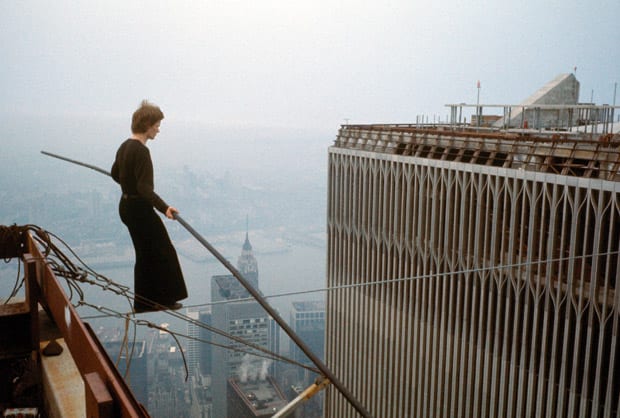
words William Wiles
A wondrous 1974 walk between the two towers of the World Trade Center would not be possible in today’s security-obsessed buildings that stifle our imagination, says William Wiles.
The strange thing about Philippe Petit’s 1974 “coup”, walking on a high-wire between the tops of the Twin Towers of the World Trade Center in New York, is that it made perfect sense. Whatever its risks, it wasn’t insane or incomprehensible – it was the entirely logical outcome of a legible thought process. “When I see three oranges, I juggle; when I see two towers, I walk,” Petit said later. This is the human engineering instinct – gaps suggest bridges, and the construction of twin towers creates a particularly spectacular gap.
James Marsh’s new film Man on Wire, a documentary remembering Petit’s walk, begins with a flash of this engineering insight. Sitting in a dentist’s waiting room, Petit sees a newspaper article about the proposed World Trade Center, with a drawing showing the height of the towers. Petit draws a line connecting the tops of the two as-yet-unbuilt skyscrapers, an act of design that has extraordinary implications. And he then follows through on his design, a story that makes for a compelling and at times very moving film.
In the years spent waiting for the World Trade Center to be built, Petit pulled off a couple of impressive but ultimately lesser coups – walking between the two towers of the cathedral of Notre Dame in Paris, and between the pylons of the Sydney Harbour Bridge. In a neat progression through the history of building types, after the religious structure and the industrial structure comes the global business linchpin in downtown NYC. Petit’s World Trade Center walk is preceded by two other feats, each audacious in its own right – getting to the top of both of the towers undetected with all the equipment, and erecting a usable wire across the manmade chasm between them, also undetected.
The acts are individually impressive, and the story of how they were achieved has all the drama and suspense of a heist movie. But they still fade to nothing set against Petit’s first, unhesitant step out into the void. That one line in the waiting room, the first step out; it’s the smallest acts in the coup that say the most about the capacity of the human spirit to transcend limitations.
Michael Bierut has called Man on Wire “the best design movie of 2008”, a film that “shows how easy it is to have an idea, and how hard – and sometimes even miraculous – it is to see it realised”. It is indeed an inspiring testament to the singular capabilities of the creative soul, and the transformative power of the creative act. But there’s a message in it that should leave architects and designers humbled as well as uplifted. The line drawn on the newspaper, the breach of the towers, and the stringing of the wire would mean nothing without the walk. The wire is “merely” design; the walk makes it art. What the design does is create a stage; it’s the space above it that matters, just as it’s the spaces within and around buildings that matter. That’s where the users are; that’s where the life is.
There is also a poignant thread running through Man on Wire. At no point is the fate of the Twin Towers mentioned, or even alluded to, but it hangs in the air, suspended between the participants and the viewers. Petit’s coup can never be repeated, not just because the towers are gone, but because public suspicion has increased, and control of public space has tightened. It is odd, and unnerving, to look back on late Nixonian America as a more innocent age.
This contrast with today makes Marsh’s film an understated rebuke to the terrorised mindset of odern officialdom. Man on Wire will provoke a cold sweat from the professional paranoiacs who assemble counter-terrorism strategies for Western governments. Petit would come unstuck long before setting foot on the wire in this new world of ID cards, blanket CCTV, motion sensors and face-recognition software. These technologies inevitably serve the status quo, reinforcing accepted uses of built space, and as such give buildings learning difficulties, reducing their ability to discover new uses and new patterns of use. We are losing the potential for the unforeseen and the spontaneous, stunting our buildings and cities, and reducing the space in which life and beauty are possible.
Man On Wire is on general release
www.manonwire.com
















